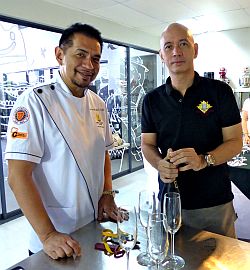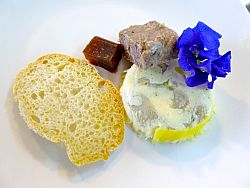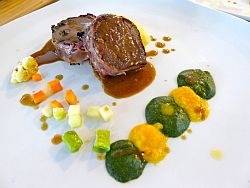
Founder & CACS President Chef Gene Gonzales and Cebu CACS Owner
Dr. Martin A. Villarica
THE INVITATION to a Basic Wine Appreciation by Chef/Sommelier Gene Gonzalez at the Center for Asian Culinary Studies by Cebu owner Dr. Martin A. Villarica was too irresistible to pass up. The food and wine pairing lunch was the last session of the six graduating students in the Certificate Program in Cooking and Baking Skills. The night before, the group prepared the culminating sixth Legacy Buffet Dinner that proudly showcased their acquired culinary skills.
Chef Eugenio “Gene” Gonzales traces his rich and opulent culinary background to the small town of Sulipan in Pampanga where the best
parties of yore were hosted by Ilustrado members of the revolution to show Spain their European brand of culture and sophistication.
He abandoned his corporate career in banking and pursued culinary education in America and Europe. In 1981, at the age of 23, he opened Café Ysabel, which featured our rich Filipino cuisine and housed a wine cellar of rare vintages.
Today, Chef Gene generously shares his food and beverage expertise and sophistication as Founder and President of his culinary school, Center for Asian Culinary Studies in Manila, Pampanga, Davao and Cebu.
I was privileged to attend the Basic Wine Appreciation. The multi-course lunch was complemented with at least 10 bottles of wine. Chef opened his wine talk by reminding us that Old Word wines are named according to appellation or place of origin (e.g. Champagne, Bordeaux, etc.) while New World wines are by grape varietals (chardonnay, cabernet sauvignon, etc.).
The wine-pairing lunch menu opened with Amuse Gueule of Chef’s Pate with crackers served with Freixenit Grand Seleccion Cordon Negro Cava from Spain. Cava is sparkling wine from Spain using grape varieties indigenous to Spain; whereas Champagne is a sparkling wine produced from grapes grown only in

Terrine of Goose Liver & Duck Rilettes with Port Wine jelly
Champagne, France. Cava is the most-champagne-like sparkling wine outside of France. There was so much to learn about sparkling wines! We had a Chilean late harvest Luis Felipe Edwards Viognier Sauvignon Blanc 2010, sweet and highly aromatic to complement Terrine of Goose Liver and Duck Rilettes.
According to Chef Gene, one must consider appearance, nose (smell) and palate that includes sweetness, acidity, tannin level, alcohol level, flavor etc. for the systematic approach to tasting wine, and he was very patient as we held the stems of our wine glasses, swirled and “nose” the aromas that newbies like us have to learn. Even the soup, Duet of Asparagus and Cream of Crab with Saffron Cream was paired with Gunderloch Gewurztraminer 2013 made with German pink skinned grape variety with a fruity nose. He shared basic guidelines in wine and food matches: lighter styled and sparkling wines (I’m a big fan of this), are ideally drunk by themselves as aperitifs while full-bodied sparkling wines must be accompanied by food.

Tournedoes Wrapped with Prosciutto
Dry, white wines are best with seafood and full-bodied reds complement red meats. In between, there are medium bodied pinot noir-based wines to
accompany roast beef and poultry.
Our exquisite lunch entrees of seared salmon, roast chicken, tournedos wrapped in prosciutto were perfectly paired with wines
selected by Chef Gene, allowing us to understand and appreciate the pairings. Pedro Ximenez Nectar was sweet and velvety smooth to our palates with dried fruits and fig aromas on the nose and complex flavors of caramel, dried fruits and nuts after enjoying Mango Sans Rival.

